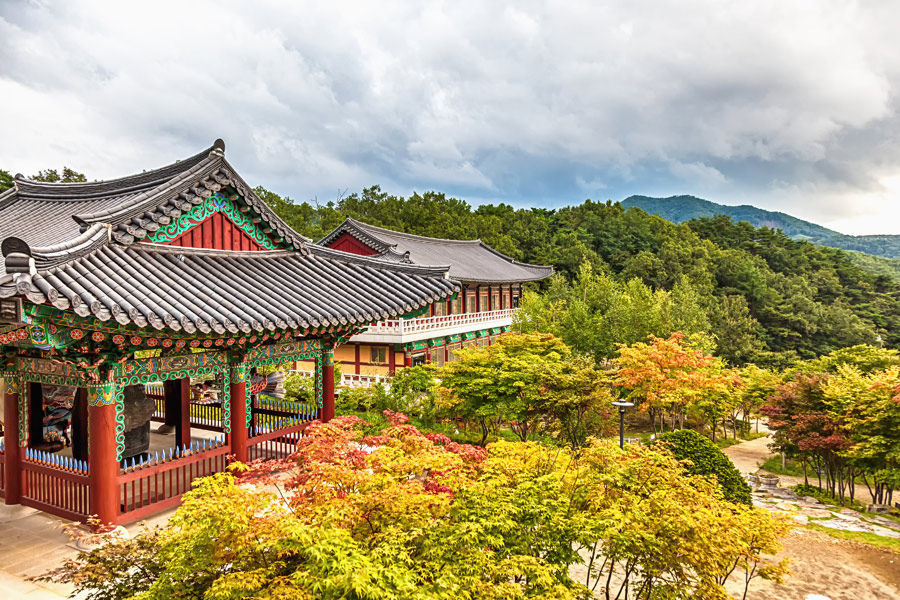[fshow photosetid=72157651938952428]
Mapped out by a mighty border of mountains to the west and sea to the east, Gyeongbuk province is widely celebrated as the epicentre of cultural Korea.
Home to a resplendent panoply of shops, restaurants and hotels, the sprawling city of Daegu offers a convenient base for visitors looking to explore the full range of Gyeongbuk’s treasures. Daegu’s downtown medicinal herb market and nearby Donghwasa Temple are also well worth fitting into your itinerary if you have more time to explore the city. Sublime mountain scenery also makes Gyeongbuk something of a mecca for hikers, however, I had travelled to the province in search of Korea’s historical gems.
The Home of Kings
The first stop on my tour of cultural Korea: Gyeongju. Nestled in the mountains a one-hour drive south of Daegu, Gyeongju was once the capital of the ancient Silla Kingdom that dominated a large portion of the Korean peninsula from the 7th-9th century. A short wander from the neon-drenched street of hotels where I was staying led me to a collection of otherworldly grassy hillocks, which I soon discovered were burial mounds of former kings and queens of the Silla dynasty. Eerily illuminated by the twilight, these pyramids of Gyeongju are best explored by bicycle in the full light of day. A few minutes of pedalling will transport you far from the hubbub of Gyeongju’s busy town centre to the tranquil green forests and traditional flower gardens that are spread between the many burial grounds.
A Mountain Retreat
A trip to Gyeongju would not be complete without a visit to Bulguksa Temple, a UNESCO World Heritage site perched in the mountains 16 kilometres above the city. If you feel confident enough to brave the winding mountain roads up to the temple, hiring a car offers a neat way to soak in the scenery on the way, as there are plenty of viewing points to stop off and take photos. Positioned on a series of stone terraces that ascend the mountainside, the crooked pines and placid ponds that pepper the temple grounds give the entire site a mystical feel. Bulguksa is also the crowning jewel of Silla architecture, and its revered pagodas boast ornate examples of Silla carpentry and paintwork.
Home of the Korean Spirit
Travelling on from Gyeongju, I visited Andong-self-branded home of the Korean spirit. Stretched along the banks of the Nakdong River, Andong embodies the bizarre juxtaposition between a traditional Korean market town and a growing industrial city. The city’s annual Mask Dance festival places it squarely on Korea’s cultural trail, and I was lucky enough to be in the city to enjoy the event’s many attractions. Held in the grounds of Andong’s riverside stadium each autumn, the festival showcases traditional Korean masked dance, in addition to the performances of professional dance troupes from across the world. The mock war between two ancient Korean armies, each comprised of several hundred men, was a particular highlight.
Escape to the Country
A 20-minute bus journey from Andong leads you to Hahoe Village, a small community of traditional ‘hanok’ houses dating back to the 16th century. Nestled in an ox-bow of the Nakdong River, the village is a precious jewel of Korean culture due to the fantastic preservation of the village’s traditional architecture. Hahoe’s Mask Museum is an entertaining way to kill half an hour before venturing into the maze of hanok, which are easily accessible via shuttle bus. If you can find it, visit the old oak tree positioned in the midst of Hahoe’s criss-crossing lanes to write your wish on a small piece of paper, before tying it to the leaves of the great tree for the gods’ consideration.
A Sunset Performance
If you find yourself in Gyeongbuk during the summer months, it’s worth checking to see if you can time your visit with one of the outdoor sunset performances at Hahoe Village. I was lucky enough to travel back to Andong in the summer, and I was able to catch an impressive dramatisation of the turbulent legend of Hahoe’s forefathers. Backlit by a dusky pink sunset, the performance took place on a floating stage, complemented by enormous illustrations projected onto the cliff behind the river. However, as the entire performance is in Korean, it’s handy to take along a Korean companion who is able to translate for you!
Don’t Miss
- If you are intrigued by Korea’s Buddhist culture, an overnight stay at Daegu’s Donghwasa temple offers a fascinating ‘day in the life’. Donghwasa is a working temple, so be prepared to sleep on the floor, eat vegetarian food with the resident monks and wake up at 4am for chanting and prayer.
- While Gyeongbuk may not be home to the same array of glitzy restaurants as Busan or Seoul, the hearty dishes that originate from this province are some of the finest Korean food you will eat. In Gyeongju, don’t miss the chance to gorge yourself on ‘ssambab’, a meal comprised entirely of delectable meat, fish and vegetable side dishes.
- Visitors exploring central Andong should make a beeline for the bustling fresh produce market to sample a bowl of the town’s signature dish-jjimdak. This spicy chicken stew is served with pickled radish in order to cool down the fiery taste of the main dish.
- If don’t mind getting a sweat on, a hike up Sobaek San-the province’s tallest mountain-affords sublime panoramic views of Gyeongbuk and its neighbouring province, Chungbuk.
- If you haven’t got time to make it all the way down to Gyeongbuk province, Suwon’s folk village (just a 40-minute train journey from Seoul) provides an intriguing window into Korea’s history. Home to authentic farm houses, tea shops and even its own mini outdoor performance arena, a trip to Suwon Folk Village offers a pleasant way to spend an afternoon.

